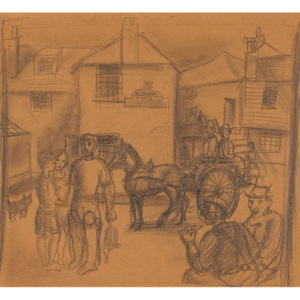-
The Sloop Inn, St Ives
Pencil on paper laid on card 21 x 31.1 cm Executed in 1926 Provenance: The artist's family until 1959 Redfern Gallery London, purchased by Dr Leonard D Hamilton on 12 June 1959 and by descent
Christopher Wood
Christopher Wood
Christopher Wood
British (1901 -1930)
Christopher Wood was born in Knowsley, near Liverpool on 7 April 1901, the son of Mrs Clare and Dr Lucius Wood. Wood’s interest in art was sparked at age 14 when he began to draw during recuperation from septicaemia, he then went on to study architecture briefly at Liverpool University (1919-20). While at University, Wood met Welsh painter Augustus John (1878 – 1961), who encouraged him to become and artist.
Encouraged by John, Wood pursued an artistic career and soon after meet the French collector Alphonse Kahn, who invited him to Paris, he enrolled at the Académie Julian in 1921. Wood entered effortlessly into fashionable Parisian artistic circles, meeting Chilean diplomat Antonio de Gandarillas, with whom he began a liaison. As well as supporting Wood financially, Gandarillas also introduced him to Picasso, Georges Auric and Jean Cocteau and to the use of opium. Opium would have a devastating effect on the artist and often added to the hallucinogenic quality of his later works.
While in Paris, Wood became a member of The London Group in 1926 and the prestigious Seven & Five Society in 1927. The London Group had been formed in 1913 by a merging of the English cubists with the urban realists group. The Seven & Five society held their first exhibition in 1920 and exhibited annually over the next sixteen years, with the exception of 1930. Frances Hodgkins exhibited with The London Group in 1927 and joined the Seven & Five Society in 1929 after being introduced to the group by Cedric Morris. Hodgkins exhibited alongside Wood in the 9th Exhibition of the Seven & Five Society. Her involvement with the group also brought her into close contact with two of Wood’s closest friends, Ben & & Winifred Nicholson. Ben Nicholson joined the society in 1924 and took over as president in 1926, his influence would steer to society into a close relationship with avant-garde developments centring on Paris.
Ben & Winifred Nicholson became enthusiastic supporters of Wood’s work. Wood painted with the Nicholson’s in Cumberland and Cornwall in 1928. A defining moment in Wood’s life was the walk he took with Ben Nicholson in the streets of St Ives in August 1928 when, through an open door, they spotted paintings of ‘dramatic sea voyages painted on an assortment of odd-shaped supports made from salvaged pieces of driftwood and cardboard torn from grocery boxes’. The work they discovered was that of the fisherman painter Alfred Wallis (1855 – 1942), whose work shared an interest in naïve art, where perspective in compositions are eschewed and objects scale is often based on its relative importance in the scene. Nicholson later commented that ‘to Wallis, his paintings were never “paintings” but actual events’. Through Nicholson and Wood, Wallis was introduced to Jim Ede who promoted his work in London.
This chance meeting helped Wood establish his own personal style. His understanding of naïve art was also influenced by his early exposure to the work of modernists in France such as Pablo Picasso, Paul Cezanne and Vincent Van Gogh, who all drew upon Non-Western art. Although there are many canvases from 1920-27 that attest to Wood’s prowess most of his best work followed his inspiration by Wallis. Especially notable are the pictures painted in 1929 both in Dieppe and the traditional fishing village of Tréboul in Brittany.
In April 1929 Wood held a solo exhibition at Tooth’s Gallery, London, where he met Lucy Wertheim, Hodgkins’ gallerist friend and dealer. She purchased a work and arranged for an exhibition at her gallery the following year. An exhibition with Ben Nicholson at the Galerie Bernheim in Paris (May 1930), in which Wood showed paintings made in Brittany in 1929, was met with less success. The results of a second stay in Brittany (June-July 1930) were intended to open the Wertheim Gallery in London in October. During the frenzied preparations for his Wertheim exhibition, Wood became psychotic and began carrying a revolver. On 21 August he travelled to meet his mother and sister for lunch at ‘The County Hotel’ in Salisbury and to show them a selection of his latest paintings. After saying goodbye and believing himself pursued (an effect of withdrawal from opium), he threw himself under the London train. Winifred Nicholson, who was so devastated by the news of his suicide that she employed a private detective to try to prove another cause of death, soon found seeds of self-destruction everywhere, and wrote of his works from 1930 that the “cost of such painting is heavy”.
In deference to his mother, his death was often subsequently described as accidental. Posthumous exhibitions were held at the Wertheim Gallery (Feb. 1931) and the Lefevre Galleries (1932). In 1938 Wood’s paintings were included in the British pavilion at the Venice Biennale. In the same year a major exhibition was organised by the Redfern Gallery at the New Burlington Galleries, which attempted to re-unite Wood’s complete works, and gave impetus to Neo-Romanticism.

